Fibre optics - a different approach to cave lighting
Abstract
In 2002 the initial steps were taken towards a new lighting system for the Kelly Hill Caves on Kangaroo Island, South Australia. The project was completed in January 2005, with fibre optic technology being chosen to light the four chambers of the show cave. The upgrade also involved a new pathway lighting system comprising of low voltage fluorescent lights and a backup uninterruptible power supply which now gives 8 hours of full system lighting in the case of power failure.
The presentation will outline the various benefits and limitations of illuminating a show cave using this technology, with particular emphasis on the benefits to the cave environment. Some of those benefits include minimal heat output, a system that requires very little maintenance and which draws significantly less power. There are several limitations, however fibre optic lighting has the potential to deliver significant positive outcomes in displaying cave environments. The presentation will also discuss the project management process as undertaken by the Department for Environment and Heritage, and its ability to deliver a staged project on budget within tight timeframes.
Kelly Hill Show Cave
The Kelly Hill Show Cave covers a distance of approximately 150m and consists of four separate chambers. The pre-existing 240-volt lighting system was comprised of approximately 120 mainly incandescent luminaires ranging from 60-watt incandescent lamps through to 150-watt floodlights. The pathway lighting system comprised of thirty-three 40 and 60 watt incandescent lamps. The caves are located within the Kelly Hill Conservation Park in the southwest corner of Kangaroo Island, South Australia. They are managed by National Parks and Wildlife South Australia through the Department for Environment and Heritage. Approximately 40,000 a visitors year visit the caves, which are accessible by guided tours that take 40 minutes.
Project Scope
The lighting upgrade was implemented to:
1. Replace the existing 240-volt chamber lighting system. This system was installed in 1983 and was considered by many as an excellent example of cave lighting. It was however beginning to show serious signs of deterioration including failing circuits, arcing at light fixtures and other regular electrical problems
2. Replace the existing 240-volt pathway lighting system which was also beginning to show signs of deterioration
3. Provide emergency back-up power during times of loss of mains electricity
Project Aims
Several aims for the new lighting system were set out, they were
1. To reduce the environmental impacts on the cave (heat output and lampenflora)
2. To reduce the maintenance requirement
3. To reduce energy consumption
4. To provide full-time emergency lighting for the cave so that tour schedules were not impacted by power failures
5. To produce a tasked lighting system that reduces the "floodlit" effect and unnecessary light spill
Project Background
After the project was initiated in 2002 by then Site Manager Jonathan Woods and Kangaroo Island District Ranger Rob Ellis, a thorough literature search was conducted on lighting technologies with a particular focus on those which would reduce environmental impacts on the cave environment. From this process, light emitting diode (LED) and optic fibre were the two preferred technologies.
It was decided that for this project optic fibre presented the better option due largely to the absence of heat at the luminaire and the minimal maintenance requirement. Cost comparisons and a less complicated electrical engineering requirement also contributed to this decision. In early 2003, GHD won the electrical engineering contract and presented the engineering documents for the new system in June 2003. After some scope reduction from the original project specifications the lighting upgrade received approval for implementation in the 2004/05 financial year, with a budget of $90,000 (to be later increased to $123,000).
Tenders were called in August 2004, and after a process of further scope reduction, price negotiation and additional project funding being sourced Kabz Electrical from Adelaide, South Australia were awarded the contract. They sub-contracted Custom Made Lighting to install the optic fibre component of the project. Andrew Hansford from the Naracoorte Caves was made available to assist for the two weeks of installation through an exchange. Andrew had assisted with the lighting of several caves in that region and his expertise was invaluable during his time on the project.
The installation of the fibre optic lighting system for the chamber lighting began in November 2004, with a timeframe of 10 days. During this time a reduced tour schedule allowed us to continue to meet our contractual obligations with tour operators whilst allowing for work to continue uninterrupted each afternoon.
The optic fibre lighting system
The optic fibre is solid core monofilament, which is an extruded polymer, coated in an additional custom cave coloured layer. This served two purposes, it allowed us to more easily hide the fibre once installed and it also adds another layer of protection.
With all optic fibre, light conductivity is achieved by light passing through the polymer core and being internally reflected by an outer Teflon mirror.
With this type of fibre, intensity of light is affected only slightly by length of fibre until runs of fibre greater than 20 metres are used.
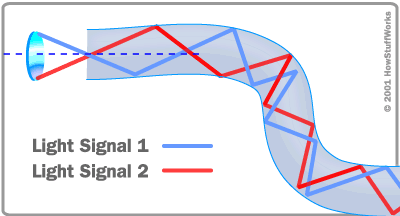 |  | 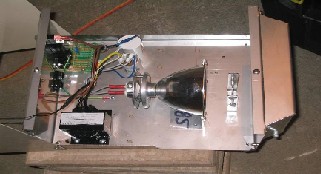 | 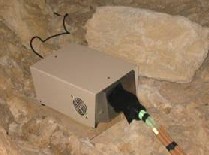 |
| Figure 1 - A diagram showing the transmission of light along an optic fibre by total internal reflection | Figure 2- a close up view of the optic fibre showing the polymer core and cave coloured exterior coating | Figure 3 - a light driver (with cover removed) showing lamp housing, infra- red filter and electrical components | Figure 4 - A light driver in position with common end inserted |
We used 4 different diameter fibres - 7mm, 9mm, 12mm and 14mm. The greater the diameter of the fibre, the more intense the light will be and vice versa so a mix of fibres was necessary for illuminating different formations as required. The fibre is quite flexible; the 9mm fibre can be looped into a 300mm circle.
A light driver provides the light for the fibres. A typical light driver is shown below. The drivers are lightweight (less than 4kg each) and the size of a large shoebox (160mm x 255mm x 325mm). Each light driver contains a 70-watt metal-halide globe. A bundle of fibres (held in place by a common end) is inserted into one end of the light driver and the light travels along them to illuminate the chambers.
Each light driver provides light to between 7 and 14 fibres (depending on fibre diameter used). One common end can accommodate fourteen 9mm fibres or seven 14mm fibres and so on. "Blackout" wheels are mounted in each driver and these allow lighting to be turned down in each chamber without turning the lamp off in the driver. A small motor rotates a wheel inside the driver which cuts light off to the fibres. These are controlled by guides at the various control panels in the cave using a silent button.
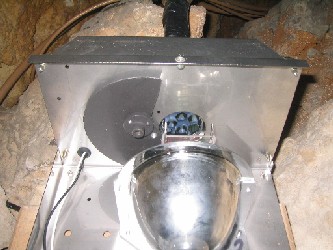 |  | 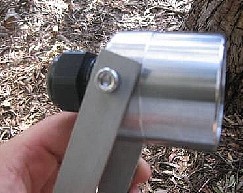 | 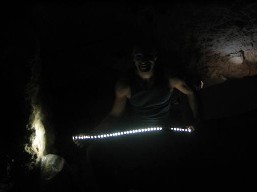 | 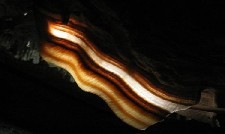 |
| Figures 5 - Blackout wheels were installed to allow for lights to be turned down without having turning the light driver off | Figure 7 & 8: Two types of 316 Marine Grade Stainless Steel light fittings were used, spotlights (7) containing polished glass lens to focus light and floodlights (8) | Figure 9 & 10: - Optic fibre can be 'notched' by cutting through the Teflon coating allowing light to leak out (9). This technique was used to light several shawls inside the cave (10) | ||
This became necessary as the metal halide lamps require a 7-12 minute cooling down period after being turned off before they will reignite. During the peak holiday periods this would have meant leaving the lights on in the chambers for much longer periods than we would have liked and may have contributed to additional lampenflora.
At the end of each fibre a watertight stainless steel (316 marine grade) fitting is used. We have used two types of fittings, spotlights and floodlights. The spotlights contain a high quality polished glass lens which allows the light from the fibre to be focussed on a particular formation. Focus strength is altered by simply fixing the fibre end at various distances from the lens. The floodlight fittings do not contain a lens and are simply in place to protect the cut end of the optic fibre.
These fittings were bolted to pavers for stability where possible. As there are no electrical or moving components in these fittings the only maintenance the luminaires will require is the occasional wiping of dust from the clear acrylic face. The fibre can also be "notched" which allows light to leak from the outer Teflon mirror and provide a long line of light. This proved very effective when lighting several shawls in the cave.
Installation of the chamber lights, pathway lighting system and UPS
The removal of the existing lighting system, the upgrade of the control panels and installation of the twelve light drivers and 114 optic fibres and their fittings was completed in 10 days by a team of 7 people.
The pathway lighting system was installed the following month over a 5-day period. The pathway lighting consists of low wattage fluorescent lamps (mostly 5 watt) mounted in cave coloured metal housings. The pathway lighting is all two-way switched for convenience and use in keeping large groups together in the cave. Where possible existing cabling and conduit was utilised.
The uninterruptible power supply (UPS) consists of 8 large batteries plus a computer unit and provides 240-volt power for the lighting system in the event of mains power failure. This is able to run the entire lighting system (chamber lights included) for a total of 8 hours. This is due largely to the low power consumption of the system (around 1300 watts in total) and will enable us to continue running tours during the regular power failures on the island.
Project Management
A three-person project team was put in place to manage the project - David Heard (Senior Ranger Flinders Chase National Park), Jonathan Woods (Site Manager Flinders Chase National Park) and Michael Kidd (Senior Guide Kelly Hill Caves). A 30-minute site meeting was conducted at 11:30am daily to enable any issues or concerns to be raised and allow various stakeholders to stay informed on progress. Contractors were briefed on the first day on cave protection and care, and their behaviour and respect for the cave during the project was exemplary. Contractual and financial management was provided by Roger Collins from DEH head office in Adelaide. A number of issues arose during the installation, but due to the open communication between contractors, DEH staff and their supervisors these issues were dealt with early and solutions put in place before they became major problems. Clear timelines were put in place throughout the project period, and this allowed the project team to keep track of progress and identify periods where extra staff input would be required. The project was completed on time and on budget, due largely to sound project management.
Monitoring of the system will be occurring for some time to eliminate teething problems and to ensure the system is working to its potential.
Advantages of optic fibre lighting
Low heat output
The chamber lighting for the caves uses only twelve 70 watt lamps in total (as there are twelve light drivers used). With the old lighting system, there were over 120 lamps being used to illuminate the four chambers. In addition to this, very little heat is generated near formations as most of the drivers are hidden in non-delicate areas and there is no heat transmitted through the fibres. The pathway lighting system utilises mainly 5 watt fluorescent lamps which have negligible heat output.
Maintenance requirement is very low
The metal halide lamps in the light drivers have an expected lifespan of 4-5 years (6000 hours). The stainless steel fittings that cover the cut end of the optic fibre require only very occasional maintenance, and this is limited to wiping dust from the clear acrylic cover. There are no electrical components at the luminaire, all electrical components are contained within the twelve light drivers that have been positioned so that they are easily accessible if maintenance needs to be carried out. This will result in reduced physical damage to formation caused when having to change light globes.
Reduced energy consumption
The optic fibre lighting system is very efficient. The 114 luminaires are lit by a total of just 12 lamps. This has resulted in a reduction of power consumption of at least 60-70%. The entire fibre optic lighting system draws just 1200 watts, compared to nearly 4000 watts for the old system.
Flexibility
The fibre optic lighting system allows for flexibility in a number of ways. The luminaire position is easily adjusted and spotlight focus is changed by altering the distance of the cut end of the fibre from the lens. Provisions have been made for future additions to the lighting system should this be required. Excess fibre was cut where possible (and coiled up out of sight) to allow luminaire position to be changed if needed in the future. The blackout wheels fitted to the light drivers allow for staging of the lighting during guided tours, each guide is able to use the lights in a variety of ways.
Silent
No cooling fans are needed on the light drivers for the 70 watt lamps, which makes the system silent. Fans were originally fitted to the drivers but testing showed they were not necessary in this cave due its relatively low temperature and so they were removed post-installation. The blackout wheel control buttons are also silent which has eliminated the 'clunk' of switches.
Possibility for better lampenflora control
The luminaires have been positioned and focussed in a way that has seen a vast reduction in light spill, which should reduce the likelihood of lampenflora outbreaks. They are also easily moved or refocussed if needed. The intensity of light is reduced with a much softer light illuminating the formations, which will control lampenflora growth.
White light
The metal halide lamps provide a clean, white light, which enables us to show the true colours of the formations. The incandescent lamps used in the old lighting system produced a yellow-orange wash over the formations they were illuminating.
No degradation of materials
High-grade stainless steel (316 marine grade) was used wherever possible (light driver casing, light fittings etc) and the optic fibre should not decay unless submerged in water.
Reduced complexity of electrical wiring
As there are only twelve light drivers there are only twelve points where electrical cabling needs to be run throughout the chambers. For the pathway lighting existing cabling and conduit was used where possible.
Fibre is easily hidden
Due to the flexibility of the fibre and the cave coloured coating it is easily hidden amongst limestone and formations. This was also aided by reducing light spill and leaving some areas of the chambers unlit where cables could not be hidden.
Disadvantages of optic fibre lighting
Lamp restrike time
The metal halide lamps used in this system require a cooling period of approximately 7 to12 minutes once switched off before they will reignite. This posed a serious problem for busier periods of the year where several groups may be in the cave at the one time. This would have meant leaving the lights on all day, which has obvious lampenflora concerns and also removes from the 'wow-factor' as the chamber lights up from darkness. This issue was addressed by installing the blackout wheels to the light drivers to enable the drivers to be left on without illuminating the chambers.
Light spill from drivers
The light drivers are not lightproof as small amounts of light are able to leak out from the casing. This was an issue in one chamber in particular where we put the tour group into total darkness. To achieve total darkness the drivers needed to be switched off which then posed the problem of restrike time as discussed above. Light catching boxes were installed over the light drivers to achieve total darkness without having to turn the drivers themselves off.
Exposed polymer can deteriorate when immersed in water
As Kelly Hill Caves are predominantly dry caves with no water bodies and very small amounts of drip water this was not a major concern. To be certain, we used waterproof fittings to cover the cut end of the optic fibre. This may be a limiting factor in caves which experience flooding or need lighting in areas where large amounts of water may be present.
Heat within light drivers
The Kelly Hill Caves have a constant temperature of about 15°C that allows for sufficient cooling of the light drivers without the need for a fan. This may not be possible in all caves and the fans do introduce an audible background noise that is difficult to mask.
Limited fibre length
There is a limit to the length of optic fibre that will efficiently transmit light. Lengths greater than 20 metres begin to lose light intensity, and intensity drops exponentially as length of fibre increases. This may be a limitation in a large cave where long runs of fibre may be necessary.
Problems and issues encountered during light upgrade
1. Optic fibre must be bleached (by running light through it) for several days before white light is emitted, prior to that the light emitted is very yellow. This is normally done prior to installation but due to the short timeframes between approval and implementation we had to do this after the fibre was installed in the cave.
2. Pathway lighting could have been mounted in a housing which was a little less intrusive
3. We had several ballasts in the light drivers fail in the first 2 months after installation. This appears to have been a faulty batch of ballasts as the replacement ballasts have operated without problem.
4. The UPS is still undergoing tests and modifications to allow it to perform as required.
5. The fibres in one light driver were burnt due to the light driver being mounted on an angle and heat accumulating at one end. This caused a gradual degradation of the fibre that went unnoticed until the light being emitted went red.
In Summary
There are undoubtedly several distinct advantages in using optic fibre to light tourist caves, with heat reduction, a very low maintenance requirement and reduced power consumption being three significant benefits. There are however several limitations with this technology as detailed above which would need to be considered when deciding how to relight a cave, as it will not be suitable for every application.
Overall, we are very pleased with the end result. There have of course been minor problems to overcome but we have received great feedback from visitors and some fantastic media exposure. It has allowed us to show the cave to visitors in an entirely new way, and the flexibility built into the system will allow future managers to adapt the lighting system as required.